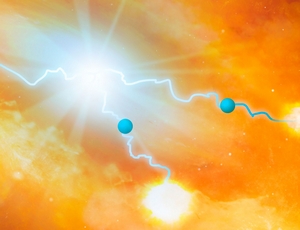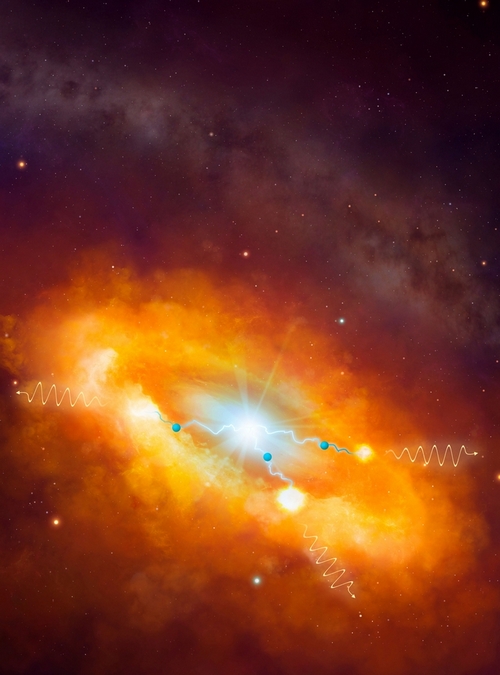
Scientists have discovered the phenomenon responsible for accelerating the Galactic cosmic rays to extreme energies. The details of the research, conducted in part by scientists from the Jagiellonian University, were published in Nature.
For over ten years, the HESS Observatory in Namibia has conducted the observation of the centre of our Galaxy, concentrating on very high energy gamma rays. This research is coordinated within the framework of the international cooperation of 42 institutions from 12 countries, including the Jagiellonian University. The results of the research, published on 16 March 2016 in Nature, revealed the source of the cosmic radiation: a supermassive black hole located in the centre of the Milky Way Galaxy – or rather, the processes which occur in its vicinity. The scientists discovered that it can accelerate cosmic rays so that the reach immense energies – sometimes even one a hundred times higher than those achieved in CERN's Large Hadron Collider in Geneva.
"Cosmic radiation factories"
Earth is constantly bombarded by high energy particles (protons, electrons and atomic nuclei) from space. This is called the cosmic radiation. It is largely influenced by interstellar magnetic fields penetrating our Galaxy. Because of this, the particles' pathways are randomly modified, which prevents direct identification of their sources; therefore, the origins of cosmic rays were one of the most mysterious concepts in science.
 Fortunately, cosmic rays interact with light and surrounding matter in the place they are created, producing gamma rays. The photons of this type of radiation travel from their point of origin toward Earth in straight lines – the magnetic field does not affect them. So, by observing them, we can identify the sources of cosmic radiation.
Fortunately, cosmic rays interact with light and surrounding matter in the place they are created, producing gamma rays. The photons of this type of radiation travel from their point of origin toward Earth in straight lines – the magnetic field does not affect them. So, by observing them, we can identify the sources of cosmic radiation.
The very technique of gamma ray observation is interesting in itself. When the ray (photon) reaches the Earth, it interacts with a particle in the upper layers of the atmosphere, creating a cascade of secondary particles, which emit a short impulse called the "Cherenkov light". By observing those impulses using telescopes with large mirrors, sensitive detectors and state-of-the-art electronics, the scientists have registered over one hundred very high energy gamma ray sources. One such instrument is the HESS Observatory in Namibia, "HESS" being the acronym for High Energy Stereoscopic System.
Research conducted in the recent years suggests that cosmic rays with energies reaching 100 teraelectronovolts (TeV; 1 TeV is equal to energy a million times higher than that of gamma radiation rays released by a nuclear explosion) are emitted in our Galaxy by objects such as remains of supernovas or pulsar nebulas. However, some theoretical arguments as well as direct measurements of Galactic cosmic rays reaching the Earth point to the fact that those "radiation factories" should be able to accelerate the particles to the energy amounting to at least one petaelectronovolt (PeV; 1 PeV is equal to 1000 TeV). Although several cosmic accelerators have been discovered, none of them possessed such a high level of energy.
Pevatrons
Somewhere in the midst of our Galaxy, in an area spanning about 30 light years, there is a source able to accelerate protons to approximately the energy of one petaelectronovolt. It has been happening for at least 1000 years.
The scientists reached a breakthrough thanks to the observations made by the HESS Observatory in the last 10 years. In the first three years, they have discovered a very strong source of gamma radiation in the centre of the Galaxy, surrounded by scattered emission from giant molecular clouds, dispersed in a 500-light year diameter. These clouds are bombarded by cosmic ray particles, which generates gamma radiation. There is very little disparity between the density of the clouds and the observed source of gamma ray emission, which suggests the presence of a cosmic ray accelerator (or accelerators) in that region.
Another analysis of detailed observations conducted at the HESS Observatory in the years 2004–2013 sheds new light on the processes of cosmic ray emission in the region. "Somewhere in the midst of our Galaxy, in an area spanning about 30 light years, there is a source able to accelerate protons to approximately the energy of one petaelectronovolt. It has been happening for at least 1000 years", said Emmanuel Moulin from the Saclay Nuclear Research Centre. Similarly to the first tevatron, i.e. a man-made accelerator capable of reaching the energy of 1 TeV, this new class of cosmic objects is called "pevatrons".
 There are a lot of objects in the centre of our Galaxy which can emit high energy cosmic radiation: remains of supernovas, pulsar nebulas or massive star clusters, but "the supermassive black hole, designated as Sgr A*, is the most probable source of PeV protons", said Felix Aharonian from the Max Planck Institute for Nuclear Physics in Heidelberg and Dublin Institute for Advanced Studies. He added: "We can take into account several potential areas of particle acceleration, both in close proximity of the black hole and farther away, where some of the material sucked into it is thrown away, allowing for particle acceleration".
There are a lot of objects in the centre of our Galaxy which can emit high energy cosmic radiation: remains of supernovas, pulsar nebulas or massive star clusters, but "the supermassive black hole, designated as Sgr A*, is the most probable source of PeV protons", said Felix Aharonian from the Max Planck Institute for Nuclear Physics in Heidelberg and Dublin Institute for Advanced Studies. He added: "We can take into account several potential areas of particle acceleration, both in close proximity of the black hole and farther away, where some of the material sucked into it is thrown away, allowing for particle acceleration".
If our black hole was a little more active in the past, it could be responsible for most of the Galactic cosmic rays that we can see today. The results of current observations are a breakthrough in a century-old debate on the origins of these mysterious particles. We can expect that further research will allow us to verify this, and further observations by the HESS Observatory, as well as the Cherenkov Telescope Array Observatory, scheduled to be opened in 2020, will expand our knowledge.
Scientists from Poland greatly contribute to the HESS Observatory research. Nicolaus Copernicus Astronomical Center in Warsaw is the Polish coordinator of the project, while its other participants include the Jagiellonian University, Polish Academy of Sciences, University of Warsaw and Nicolaus Copernicus University in Toruń.
Photos (top to bottom): HESS Observatory in Namibia (HESS Collaboration), Artist's rendition of particle acceleration near a black hole (Mark A. Garlick / HESS Collaboration)
Original text: www.nauka.uj.edu.pl





